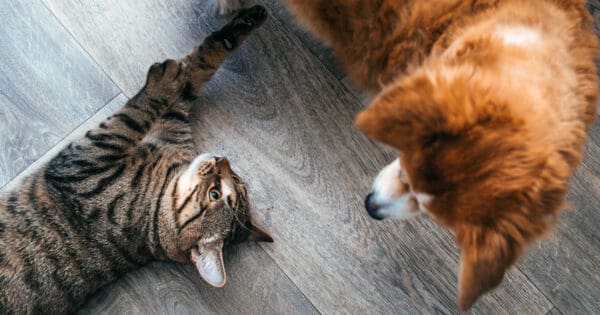Greetings and salutations, humans!
You would be amazed at how many poisons are hiding in plain sight around the house. Of course you’re probably aware of the usual suspects, like chocolate or pesticides, but some of the worst things for us dogs and cats might be within paws reach! Here are some tips on what could be really bad for us, how to poison-proof your house, and what to do if your pup does get into something bad!
Thanks to www.petpoisonhelpline.com, here are the top ten most frequently reported poisons that pets ingested.
Dogs:
- Chocolate
- Xylitol
- NSAIDs
- Over the counter cough, cold and allergy medications
- Rodenticides (mouse poison)
- Grapes and raisins
- Insect bait stations
- Prescription ADD/ADHD medications
- Glucosamine joint supplements
- Silica gel packets and oxygen absorbers
Cats:
- Lilies
- Household cleaners
- Flea and tick spot-on products for dogs
- Antidepressants
- NSAIDs
- Prescription ADD/ADHD medications
- Over the counter cough, cold and allergy medications
- Plants containing insoluble calcium oxalate crystals
- Household insecticides
- Glow sticks and glow jewelry
Poison-Proofing for Fido and Kitty
Making the house safer for us little guys is simple and easy. Taking a moment to make these changes could save our lives!
- Keep your food on your plate. Every dog wants people food (I know I love a good cheeseburger or two… Or three…), but even things that seem safe may not be, due to spices or seasonings. Even though we want your yummy people food for ourselves, you’ve got to use your better judgment and just say no. It pains me to say it, but, it’s in our best interest. SIGH.
- Medications should be secure and kept away from common areas you share with us in the house. A pill bottle being knocked onto the floor accidentally could mean BIG trouble. It’s also a good idea to avoid taking medication when we’re hovering around your feet. If you drop a pill we may snap it up thinking it’s a treat!
- Sheds, garages, basements, under porches… these are all great places for us dogs to find dangerous things to get into. Make sure to block access to anywhere that you store chemicals or other icky substances.
What To Do If Your Pet Gets Poisoned
Keep the telephone number of the ASPCA Animal Poison Control Center—(888) 426-4435— and that of your regular vet on the fridge, or somewhere else that’s easy to remember. Follow poison control or your vet’s instructions for administering the supplies in your kit.
Put together an emergency first-aid kit for your pet. The kit should contain:
- A fresh bottle of hydrogen peroxide, 3 percent USP (to induce vomiting)
- A turkey baster, bulb syringe or large medicine syringe (to administer peroxide)
- Saline eye solution
- Artificial tear gel (to lubricate eyes after flushing)
- Mild grease-cutting dishwashing liquid (for bathing)
- Forceps (to remove stingers or splinters)
- A muzzle (we can’t always keep it together when we’re scared or excited, sorry)
- A can of your pet’s favorite wet food
- A pet carrier (great for containing the rest of the first-aid items!)
We animals don’t have the greatest self-control when it comes to eating things we shouldn’t, so I hope this helps you people to help us stay safe and healthy! No trips to the emergency room for you, my fabulous followers.
Over and Out,
Finley
Execute Canine Quality Control Officer
Cascade Kennels, INC.



